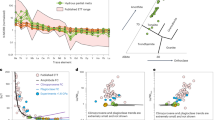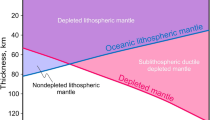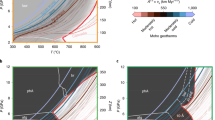Abstract
The subduction of oceanic lithosphere into the Earth's deep interior is thought to drive convection and create chemical heterogeneity in the mantle. The oceanic lithosphere as a whole, however, might not subduct uniformly: the fate of basaltic crust may differ from that of the underlying peridotite layer because of differences in chemistry, density and melting temperature. It has been suggested that subducted basaltic crust may in fact become buoyant at the mantle's 660-km discontinuity, remaining buoyant to depths of at least 800 km, and therefore might be gravitationally trapped at this boundary to form a garnetite layer1, 2. Here we report the phase relations and melting temperatures of natural mid-ocean ridge basalt at pressures up to 64 GPa (corresponding to ∼1,500 km depth). We find that the former basaltic crust is no longer buoyant when it transforms to a perovskitite lithology at about 720 km depth, and that this transition boundary has a positive pressure–temperature slope, in contrast to the negative slope of the transition boundary in peridotite. We therefore predict that basaltic crust with perovskitite lithology would gravitationally sink into the deep mantle. Our melting data suggest that, at the base of the lower mantle, the former basaltic crust would be partially molten if temperatures there were to exceed 4,000 K.
This is a preview of subscription content, access via your institution
Access options
Subscribe to this journal
Receive 51 print issues and online access
$199.00 per year
only $3.90 per issue
Buy this article
- Purchase on Springer Link
- Instant access to full article PDF
Prices may be subject to local taxes which are calculated during checkout


Similar content being viewed by others
References
Irifune, T. & Ringwood, A. E. Phase transformations in subducted oceanic crust and buoyancy relationships at depths of 600–800 km in the mantle. Earth Planet. Sci. Lett. 117, 101–110 (1993).
Ringwood, A. E. Role of the transition zone and 660 km discontinuity in mantle dynamics. Phys. Earth Planet. Inter. 86, 5–24 (1994).
Bertka, C. M. & Fei, Y. Mineralogy of Matian interior up to core-mantle boundary pressures. J. Geophys. Res. 102, 5251–5264 (1997).
Irifune, T., Ringwood, A. E. & Hibberson, W. O. Subduction of continental crust and terrigenous and pelagic sediments: an experimental study. Earth Planet. Sci. Lett. 126, 351–368 (1994).
Irifune, T., Koizumi, T. & Ando, J. An experimental study of the garnet-perovskite transformation in the system MgSiO3-Mg3Al2Si3O12. Phys. Earth Planet. Inter. 96, 147–157 (1996).
Hirose, K. & Fei, Y. Majorite-perovskite transformation on the join MgSiO3Mg3Al2Si3O12and its role in the dynamics at the 660-km discontinuity. Phys. Earth Planet. Inter. (submitted).
Kesson, S. E., Fitz Gerald, J. D. & Shelley, J. M. Mineralogy and dynamics of a pyrolite lower mantle. Nature 393, 252–255 (1998).
Faust, J. & Knittle, E. The stability and equation of state of majoritic garnet synthesised from natural basalt at mantle conditions. Geophys. Res. Lett. 23, 3377–3380 (1996).
Kesson, S. E., Fitz Gerald, J. D. & Shelley, J. M. G. Mineral chemistry and density of subducted basaltic crust at lower-mantle pressures. Nature 372, 767–769 (1994).
Irifune, T. & Ringwood, A. E. Phase transformation in a harzburgite composition to 26 GPa: implications for dynamical behaviour of the subducting slab. Earth Planet. Sci. Let. 86, 365–376 (1987).
Shen, G., Mao, H. & Hemley, R. J. Laser-heated diamond anvil cell technique: double-sided heating with multimode Nd:YAG laser. Proc. ISAM '96 149–152 (1996).
Yasuda, A., Fujii, T. & Kurita, K. Melting phase relations of an anhydrous mid-ocean ridge basalt from 3 to 20 GPa: implications for the behavior of subducted oceanic crust in the mantle. J. Geophys. Res. 99, 9401–9414 (1994).
Zerr, A. & Boehler, R. Melting of (Mg,Fe)SiO3-perovskite to 625 kilobars: indication of a high melting temperature in the lower mantle. Science 262, 553–555 (1993).
Shen, G. & Lazor, P. Measurement of melting temperatures of some minerals under lower mantle pressures. J. Geophys. Res. 100, 17699–17713 (1995).
Zerr, A., Serghiou, G. & Boehler, R. Melting of CaSiO3perovskite to 430 kbar and first in-situ measurements of lower mantle eutectic temperatures. Geophys. Res. Lett. 24, 909–912 (1997).
Presnall, D. C. & Gasparik, T. Melting of enstatite (MgSiO3) from 10 to 16.5 GPa and the forsterite (Mg2SiO4)-majorite (MgSiO3) eutectic at 16.5 GPa: implications for the origin of the mantle. J. Geophys. Res. 95, 15771–15777 (1990).
Zerr, A., Diegeler, A. & Boehler, R. Solidus of Earth's deep mantle. Science 281, 243–246 (1998).
Kendall, J. M. & Silver, P. Constraints from seismic anisotropy in the lowermost mantle. Nature 381, 409–412 (1996).
Kendall, J. M. & Silver, P. Investigating causes of D″ anisotropy. AGU Monogr. (in the press).
Williams, Q. & Garnero, E. Seismic evidence for partial melt at the base of Earth's mantle. Science 273, 1528–1530 (1996).
Revenaugh, J. S. & Meyer, R. Seismic evidence of partial melt within a possibly ubiquitous low velocity layer at the base of the mantle. Science 277, 670–673 (1997).
Simon, F. E. & Glatzel, G. Fusion-pressure curve. Z. Anorg. Allg. Chem. 178, 309 (1929).
Kraut, E. A. & Kennedy, G. C. New melting law at high pressures. Phys. Rev. Lett. 16, 608–609 (1966).
Boehler, R. Melting temperature of the Earth's mantle and core: Earth's thermal structure. Annu. Rev. Earth Planet. Sci. 15–40 (1996).
Mao, H. K., Chen, L. C., Hemley, R. J., Jephcoat, A. P. & Wu, Y. Stability and equation of state of CaSiO3-perovskite to 134 GPa. J. Geophys. Res. 94, 17889–17894 (1989).
Acknowledgements
We thank W. Minarik, J. Konzett, G. Shen and S. Shieh for discussions. This research was supported by the NSF, the Carnegie Institution of Washington, and Japan Society for the Promotion of Science.
Author information
Authors and Affiliations
Corresponding author
Rights and permissions
About this article
Cite this article
Hirose, K., Fei, Y., Ma, Y. et al. The fate of subducted basaltic crust in the Earth's lower mantle. Nature 397, 53–56 (1999). https://doi.org/10.1038/16225
Received:
Accepted:
Issue Date:
DOI: https://doi.org/10.1038/16225
This article is cited by
-
Hydrogen partitioning between stishovite and hydrous phase δ: implications for water cycle and distribution in the lower mantle
Progress in Earth and Planetary Science (2024)
-
Pressure dependence of metal–silicate partitioning explains the mantle phosphorus abundance
Scientific Reports (2024)
-
Cubic Fe-bearing majorite synthesized at 18–25 GPa and 1000 °C: implications for element transport, subducted slab rheology and diamond formation
Scientific Reports (2023)
-
Buoyancy of slabs and plumes enhanced by curved post-garnet phase boundary
Nature Geoscience (2023)
-
How lowermost mantle viscosity controls the chemical structure of Earth’s deep interior
Communications Earth & Environment (2023)
Comments
By submitting a comment you agree to abide by our Terms and Community Guidelines. If you find something abusive or that does not comply with our terms or guidelines please flag it as inappropriate.




